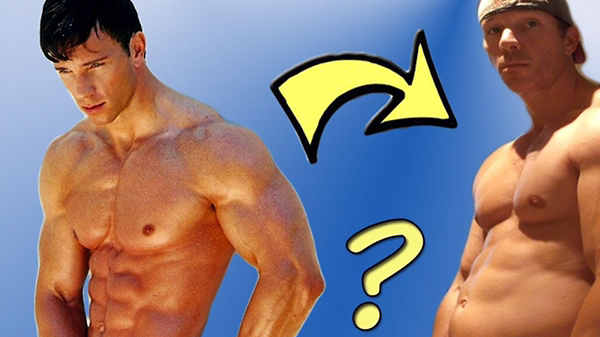By exercising to lose weight, all the excess fat and flab on the body are converted into fat, which sounds like a good thing, and logically seems logical, after all, whether fat or lean, it is all part of our body.
This idea is akin to believing that weight loss is a one-way process, from fat to muscle.
However, this is often a misunderstood notion: fat and muscle are two completely different tissue structures and cannot easily switch states.
Therefore, to achieve a good figure, what we actually need to do is a two-way process, muscle building + fat loss, both of which are indispensable.
What happens if you only build muscle without losing fat?
It will be like the figure below, though muscular, it will be bulky, with muscles buried beneath a layer of fat, appearing large but lacking definition.
What if you only lose fat without building muscle?
You will end up like this, becoming a shapeless stick, with a flat body.
If you want to create a curvy and well-defined attractive figure, you must approach it from both directions.
How should you go about this two-way process? In general, it’s about “feeding muscles, starving fat,” let’s analyze it from the perspectives of diet and exercise.
Feeding Muscles
Protein! Protein! It is your muscles’ best friend; this is probably the most crucial point. To feed your muscles, you must start tracking if your daily protein intake is sufficient.
Typically, for muscle gain, you need to consume 2-3g of protein per kilogram of body weight. For example, if a 50 kg person wants to build muscle, consuming 150g of protein per day would be good.
This amount of protein should be consumed throughout the day to keep our body feeling continually filled with amino acids, preventing muscle fiber breakdown.
Furthermore, one should engage in resistance training to stimulate muscle growth. Spending a lot of time on low-weight, high-repetition exercises is not the most effective way to build muscle. The difference in effectiveness between doing 100 bodyweight squats and 3×10 squats with 30kg of weight is quite evident.
Additionally, try to increase the weight with each training session; continually increasing the workload on the muscles helps them grow faster. If you use the same weight every time you go to the gym, your body will adapt gradually, and you will find the exercise effortless. This is dangerous for muscle building: the process should not be comfortable but should push your muscles to their very limit every time.
In terms of exercise, focus on compound movements: squats, deadlifts, bench press, rows – these exercises engage multiple muscle groups simultaneously and allow you to lift heavier weights.
Starving Fat
First and foremost, don’t worry, starving fat doesn’t mean starving yourself! As long as you choose the right food, you can eat to your heart’s content at every meal, while fat steadily decreases.
The first step is to control carbohydrates properly, ensuring that the carbohydrates you consume are utilized rather than stored in your body. The best times to consume carbohydrates are two hours before and after exercise, providing energy for your training. At other times, it’s best to consume carbohydrates through fiber-rich vegetables.
Avoid foods like buttered bread, instant noodles, and fried rice; these carbohydrates are a feast for fat, guaranteeing an increase in your waistline. Opt for coarse grains like oats, brown rice, or root vegetables like sweet potatoes, potatoes, and lotus roots. These foods not only keep you fuller but also provide ample energy and nutrients.
When trying to lose fat, the total daily carbohydrate intake must be controlled; otherwise, the excess unused carbs will be converted directly into fat. We recommend consuming 2-3g of carbohydrates per kilogram of body weight. On days without training, the carbohydrate intake can be lower, like consuming 1.5g of carbs per kilogram of body weight.
Regarding exercise, many people think that to lose fat, they need to put in hours of aerobic exercise. While this method can burn a significant number of calories, excessive aerobic exercise can lead to muscle loss, which goes against our first principle.
Therefore, the best way to exercise is through high-intensity interval training (HIIT) rather than traditional aerobic exercises. HIIT ensures that you burn calories while preserving muscle mass and helps the body utilize fat as an energy source more efficiently – a win-win situation.
Warm up for 3-5 minutes to get your body warmed up, then exert all your energy for about 1 minute, followed by a 2-4 minute rest to allow your heart rate to return to normal. Then, start the intense exercise for another minute; this is the essence of doing HIIT. Since more than half of the time is spent in recovery, give your all during the short bursts of activity – run at maximum speed or perform non-stop movements like burpees and high knees.
Due to the significant physical strain of HIIT, it is not recommended to practice it every day; 1-3 times a week is sufficient as we need energy to lift weights. Results from this regimen are sure to please you, with the layer of excess fat gradually disappearing, bringing out more defined muscle lines.
Do you usually feed your muscles sufficiently? Feel free to leave a comment telling us your thoughts on today’s article.


